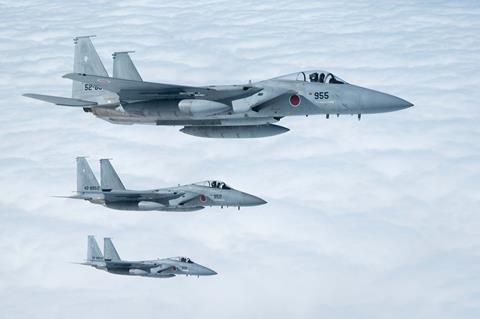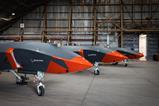Japan will spend $474.5 million to equip its fleet of Boeing F-15J fighters with an electronic warfare system designed to help the fourth-generation jet survive in contested airspace.
The US Department of Defense on 7 September said it issued a Foreign Military Sales contract, on behalf of Tokyo, under which Boeing will install the Eagle Passive Warning Survivability System (EPAWSS) on Japan Air Self-Defense Force F-15s.

Tokyo operates 155 of the air-superiority fighters, according to Cirium fleets data. The J variant of the F-15 is the Japan-specific version of the F-15C/D, produced under license by Japanese manufacturer Mitsubishi.
The EPAWSS electronic warfare system was designed for use on the type by UK manufacturer BAE Systems, under contract from F-15 producer Boeing. The system provides each F-15 with “fully-integrated radar warning, geolocation, situational awareness and self-protection solutions”, according to BAE. The technology enables crew to detect and defeat surface and airborne threats.
Through the collection of electromagnetic signals, the onboard EPAWSS hardware “instantaneously” builds a 360° picture of surrounding battle space, BAE says.
Vulnerability to radar detection is considered a major weakness of legacy combat aircraft like F-15s. Newer fifth-generation types like Lockheed Martin’s F-35 Lightning II and F-22 Raptor have stealth technology to significantly reduce their radar signatures.
Boeing argues that advanced avionics and electronic protection measures such as EPAWSS can mitigate vulnerability enough to keep fourth-generation fighters relevant in a modern air-defence environment. The company is pitching the latest F-15EX variant as a powerful complement to stealth fighters like F-35s.
Japan plans to acquire 147 F-35s, including a mix of the conventional F-35A and short take-off and vertical landing F-35B variants.
While F-35s provide improved survivability in contested environments, the F-15EX boasts a substantially larger payload for weapons or fuel. F-35As have an 8,160kg (18,000lb) payload capacity, according to the US Air Force.
“What discriminates [the F-15EX] is that it has a very significant weapons load and very significant range,” Boeing’s vice-president for air dominance Steve Nordlund told FlightGlobal during a June tour of the company’s F-15EX production line near St Louis, Missouri.
The US Air Force plans to acquire at least 104 F-15EXs. Indonesia in August signed a memorandum of understanding with Boeing to procure up to 24 of the jets.
Boeing has also been pursuing Poland as a third F-15EX customer. Warsaw is engaged in a significant expansion of defence spending, with fighter aircraft a primary focus.































